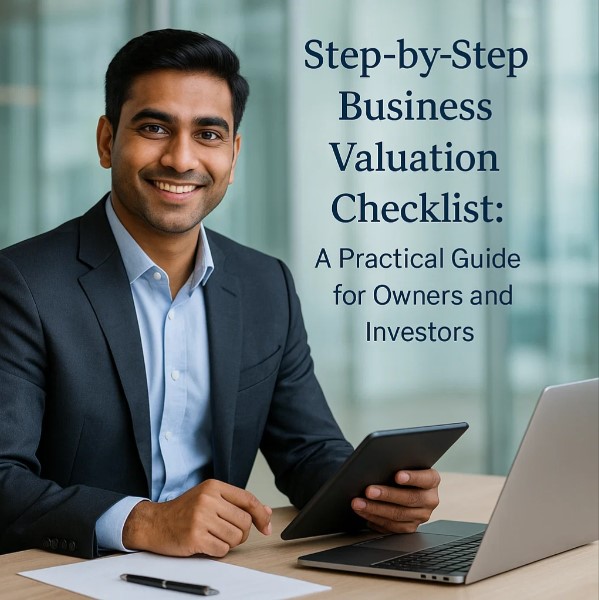
Step-by-Step Business Valuation Checklist: A Practical Guide for Owners and Investors
Valuing a business isn’t only about attaching a number—it’s about understanding its true market worth. Whether you’re selling, raising capital, planning succession, or negotiating with lenders, this step-by-step checklist will help owners and investors approach valuation with clarity and confidence.
Do your assets, earnings, and market position tell the full story?
A well-prepared valuation is more than a price tag— it’s a roadmap for growth, investment, and opportunity.
Step 1: Clarify the Purpose of the Valuation
The “why” shapes your method, assumptions, and depth of analysis.
- Selling the business: Emphasize future earnings and risk profile.
- Raising investment: Highlight scalability, unit economics, and ROI potential.
- Estate/succession planning: Focus on fair market value and compliance needs.
- Financing or lending: Underscore asset coverage and cash flow stability.
Step 2: Gather Key Financial Documents
Reliable inputs lead to reliable valuations. Assemble at least 3–5 years of:
- Profit & Loss statements and Balance sheets
- Cash flow statements and Tax returns
- Debt schedules, AR/AP aging, and capitalization table (if applicable)
- Forecasts/budgets with key assumptions
Step 3: Normalize Financials
Adjust historical results to reflect ongoing, repeatable performance.
- Remove one-offs: Lawsuit costs, unusual repairs, COVID-era anomalies.
- Adjust owner perks: Personal expenses run through the business.
- Exclude non-operating items: Gains/losses unrelated to core operations.
Step 4: Evaluate Assets and Liabilities
Understand what the company owns—and owes.
- Tangible assets: Real estate, machinery, vehicles, inventory.
- Intangibles: IP, trademarks, brand equity, customer contracts, goodwill.
- Liabilities: Short/long-term debt, leases, contingent obligations.
- Book vs. fair market value: Note gaps that may require appraisal.
Step 5: Choose the Right Valuation Method
There’s no one-size-fits-all—select the approach that fits your context.
-
Income Approach (DCF): Forecast free cash flows and discount to present value.
Best for: Businesses with predictable earnings and robust forecasts.
-
Market Approach: Compare to public comps or recent private transactions.
Best for: Sectors with abundant comparable data and active deal markets.
-
Asset-Based Approach: Assets minus liabilities (adjusted to market).
Best for: Asset-heavy companies or liquidation contexts.
Step 6: Assess Industry and Market Conditions
External forces influence risk, growth, and valuation multiples.
- Industry trajectory: Growth rates, disruption, regulation.
- Competitive intensity: Market share, pricing power, barriers to entry.
- Macro environment: Interest rates, inflation, consumer demand.
Step 7: Apply Valuation Multiples
Use multiples as a market “sanity check.” Ensure apples-to-apples comparisons.
- EBITDA multiples: Common for profitable, mature businesses.
- Revenue multiples: Useful for early-stage or SaaS with reinvestment.
- Earnings (P/E) multiples: Best where net income is stable/meaningful.
- Sector-specific KPIs: e.g., ARR, ARPU, LTV/CAC for subscription models.

Step 8: Reconcile and Finalize a Valuation Range
Different methods rarely match exactly—synthesize into a defensible range.
- Weight methods: Allocate by relevance (e.g., DCF 50%, market 40%, assets 10%).
- Qualitative overlays: Management strength, customer concentration, brand.
- Sensitivity checks: Test growth, margin, and discount-rate scenarios.
Step 9: Document and Communicate Results
Clarity builds trust and speeds decisions.
- State the purpose and scope of the valuation.
- Explain methodologies, assumptions, and data sources.
- Present the valuation range and rationale for weightings.
- Tailor the report for buyers, investors, lenders, or regulators.
Pro Tips to Elevate Your Valuation
- Clean your data: Reconcile books, fix classification errors, document adjustments.
- Segment performance: Break out product lines or regions to spotlight winners.
- De-risk the story: Address churn, supplier dependence, or key-person risk.
- Refresh regularly: Revisit your valuation annually or before major events.
Conclusion
Business valuation blends numbers and judgment. By following this checklist—clarifying purpose, organizing financials, choosing appropriate methods, and reconciling results—you’ll produce a valuation that is not just accurate, but actionable. For complex cases (cross-border operations, IP-heavy portfolios, or hyper-growth startups), consider partnering with professional advisors to validate assumptions and strengthen credibility.
